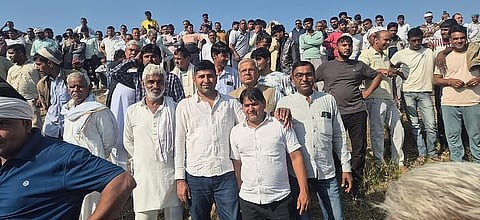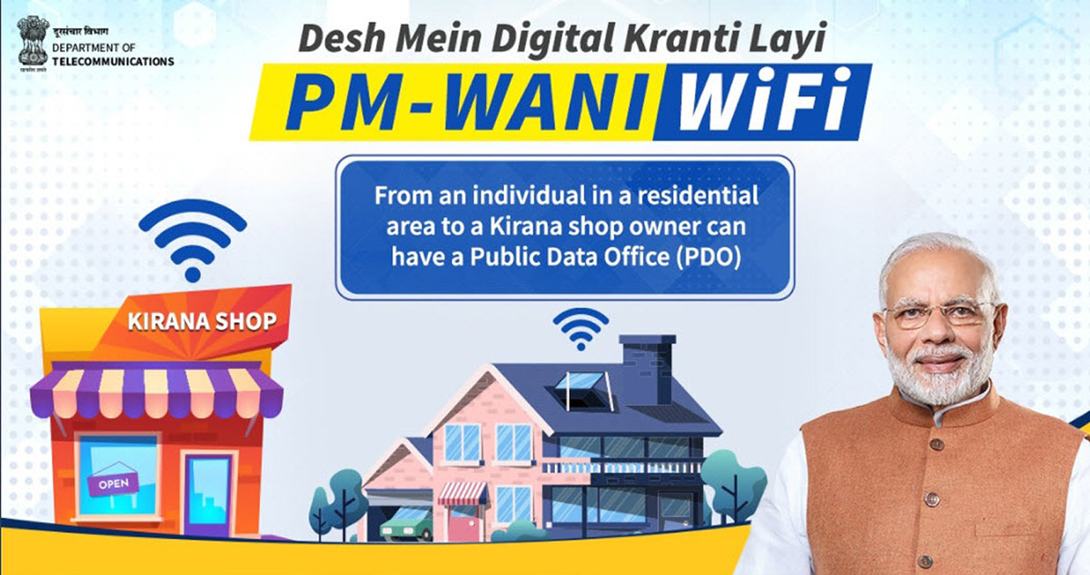



The Pradhan Mantri Fasal Bima Yojana (PMFBY) aims to provide financial protection to farmers against crop losses due to natural calamities, pests, and diseases. However, in Rajasthan, farmers have protested over delayed and arbitrary claim settlements, citing collusion between insurance companies and officials. Nearly ₹947 crore in claims remain unpaid, and issues such as poor field verification, lack of transparency, and reduced budget allocations have weakened trust in the scheme. Recent reforms, including digital monitoring through the National Crop Insurance Portal and strict timelines for claim settlement, seek to improve efficiency, accountability, and farmer confidence in PMFBY.

Copyright infringement not intended
Picture Courtesy: Down to Earth
Farmer agitations in Rajasthan, especially in districts like Churu, Nagaur, Jodhpur, Jaipur, and Ajmer, reflect deeper structural problems in the implementation of the Pradhan Mantri Fasal Bima Yojana (PMFBY).
|
Background In November 2025, farmers in Churu district mobilised the Kisan Ekta Tractor March seeking resolution of long-pending demands. The administration halted the march and seized tractors, following which negotiations with the state agriculture minister led to a temporary suspension of the protest. Key immediate demands included:
This protest highlighted long-standing dissatisfaction with PMFBY implementation. |
Pradhan Mantri Fasal Bima Yojana (PMFBY), launched in 2016, is India’s flagship crop insurance scheme aimed at providing financial support to farmers in the event of crop failure, reducing their distress, and stabilising farm incomes. It replaced earlier schemes like NAIS and MNAIS with a more streamlined and technology-backed approach.
|
Must Read: Pradhan Mantri Fasal Bima Yojana (PMFBY) | |
Importance:
Uniform Premium Structure: A core strength of PMFBY is its low, uniform premium rates for farmers—2 percent for Kharif crops, 1.5 percent for Rabi crops, and 5 percent for commercial and horticultural crops.
Comprehensive Coverage Across the Crop Cycle: PMFBY is broader than earlier schemes because it covers risks from pre-sowing to post-harvest, ensuring farmers are protected against both climate-related uncertainties and crop-cycle disruptions.
Technology-Driven Crop Assessment and Transparency: To address the past challenges of delayed and inaccurate loss estimation, PMFBY emphasizes the use of:
Structured Roles of Implementing Agencies: Implementation is shared between Public sector insurers, empanelled private insurers selected through competitive bidding and banks, Primary Agriculture Credit Societies, and Common Service Centres
Streamlined Claim Settlement with Accountability: PMFBY legally mandates insurance companies to settle claims within 2 months of harvest, making it more time-bound than older schemes like NAIS. In case of delays, companies must pay 12 percent interest, while states must release their premium subsidy within three months, failing which they are liable to pay interest to insurers.
Objectives:
Delayed claim settlements: Many farmers report that insurance companies are not settling claims on time, even though the scheme stipulates a two-month window after harvest.
State fiscal Stress: Some states (for example, Andhra Pradesh, Rajasthan, Madhya Pradesh) are delaying or defaulting on their share of the premium subsidies.
Assessment and data problems: Crop loss assessment is still often done using manual, traditional methods, which are slow and unreliable. There are gaps in data: poor land records (especially for tenant farmers), lack of reliable farm-gate price data, and inconsistent yield estimates.
Low private sector confidence: Because of repeated delays in claim payments and high claim ratios, private insurers are becoming less confident about participating. Some insurers lack presence at the local (tehsil) level, making it difficult for farmers to interact, file claims, or get information.
Budget cuts: The 2025–26 Union Budget cut the allocation for PMFBY to ₹12,242.27 crore, which is 23% lower than the 2024-25 revised estimates. This reduction in funding comes at a time when crop losses (due to climate events) are reportedly rising, which threatens the scheme’s sustainability.
Risk of fraud and misuse: There are reports of agents misusing farmers’ data (like land, Aadhaar) to enroll them or promise compensation in return for a cut. In some cases, insurance companies may not be strictly penalised for default or fraudulent practices.
|
CASE STUDY In 2025, farmers across Rajasthan—particularly in Churu, Jodhpur, Nagaur and Jaipur—protested against delays and irregularities in PMFBY claim settlements. Despite reporting crop losses due to erratic weather and disease, many farmers did not receive compensation. By July 2025, ₹947.72 crore in claims remained pending, far beyond the two-month settlement timeline mandated under PMFBY. Farmers alleged arbitrary claim rejections, lack of field surveys, and collusion between insurance companies and officials, including forged signatures on crop loss reports. A Jhunjhunu farmer, Bhagirath Chaudhary, lost 50–70% of his crop for three seasons yet received no claim. |
PMFBY 2.0 Reforms (2020)
The government introduced major structural changes to make the scheme more flexible, farmer-centric, and financially sustainable.
Key reforms include:
Increased Use of Technology for Accuracy & Timely Payments
To reduce delays and improve transparency, GoI has promoted:
Strengthening the National Crop Insurance Portal (NCIP): The Government has significantly upgraded the National Crop Insurance Portal to function as a comprehensive digital backbone for PMFBY. Instead of relying on fragmented state-level systems, NCIP now serves as a unified, end-to-end digital ecosystem integrating all stakeholders—farmers, state governments, insurance companies, banks and CCE teams. It streamlines the entire insurance cycle by enabling digital enrolment, automated premium calculation, seamless subsidy disbursal, and real-time capture of crop-cutting experiment (CCE) data.
Reforms to reduce claim settlement delays: Insurance companies are now legally required to settle claims within two months of harvest, ensuring that farmers receive compensation when they need it most. To discourage delays, the government has instituted a 12% penal interest on companies for overdue payments, creating financial accountability.
Similarly, State governments must release their share of premium subsidies promptly, and any delays now attract a 10% interest penalty.
Strengthening Grievance Redressal through “Meri Fasal, Mera Bima”: To enhance transparency and trust in PMFBY, the government launched the “Meri Fasal, Mera Bima” initiative as a dedicated grievance redressal and farmer-support mechanism. The platform provides farmers with state-wise toll-free helplines, an online system to track claim status, submit complaints, and access support services.
The ongoing reforms to PMFBY reflect the government’s effort to make crop insurance more transparent, timely, and farmer-centric. While challenges persist—especially in claim settlement and accountability—the push for digital systems, stricter timelines, and stronger grievance mechanisms signals a shift toward a more reliable and responsive risk-protection framework for India’s farmers.
Source: Down to Earth
|
Practice Question Q. Despite being a flagship risk-mitigation initiative, the Pradhan Mantri Fasal Bima Yojana (PMFBY) continues to face issues of delayed settlements, arbitrary assessments, and poor transparency. Discuss the major challenges in its implementation, using recent examples from Rajasthan. Suggest measures to strengthen the scheme. |
Farmers allege delayed payments, arbitrary claim rejections, lack of field surveys, and collusion between insurance firms and officials. Nearly ₹947 crore in claims from 2020–21 to 2023–24 remain pending.
It provides financial support for crop losses due to natural calamities, pests, diseases, and extreme weather, covering losses from pre-sowing to post-harvest.
Insurance companies must settle claims within two months of harvest; delays attract 12% penal interest.






© 2025 iasgyan. All right reserved